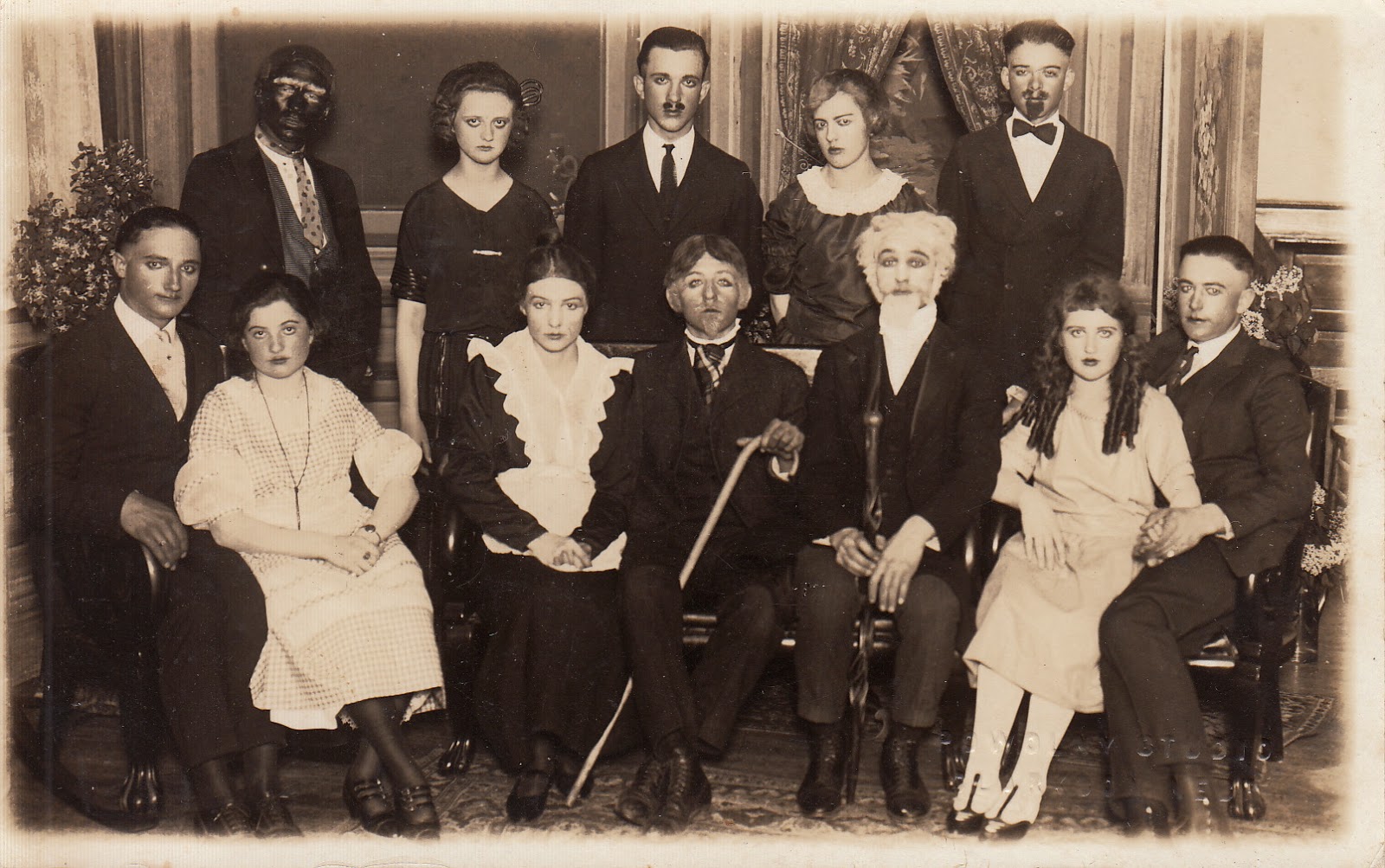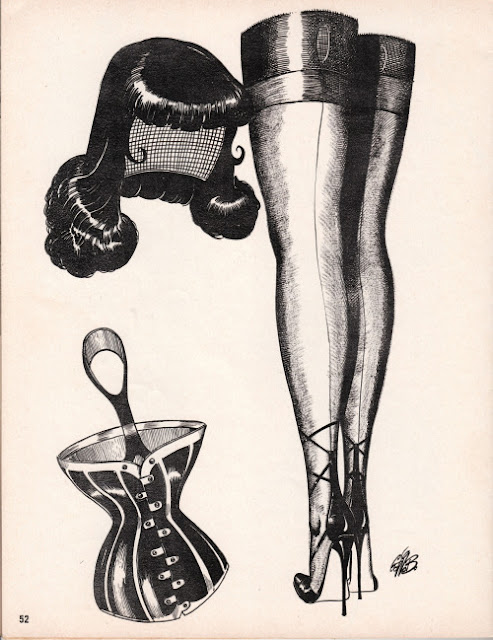


Jay Jackson isn't best known for superheroes, but he certainly was one. He was also fearless. Who but a hero would draw this image at a time when integration was unheard of, segregation was the unwritten law and yes, African-Americans were still being beaten when they dared to say the races should get along. Much less that they might interact in skimpy attire. At the time this postcard was drawn by Mr. Jackson, swimming pools were segregated. If you watch the news, you know we still have a long way to go.
Jay Jackson was Black cartoonist who drew white pinups, but he did much more. He spent most of his life encouraging understanding between the races and teaching valuable lessons with humor and insight in his comics.
One would think the simple risqué "girly" postcards would be as disposable as the one cent stamp used to mail them in the 1940s, but the splendid HERE IT IS !! IN BLACK AND WHITE postcard was found in no less than Langston Hughes archives after he passed. It was that notable. Langston Hughes saved the postcard.
So am I. It comes up on ebay once in a while, and it is just about the best way you can spend ten bucks.


Why did Jackson draw white pinups? Because in 1945, even a penny postcard required expendable income for the members of his own race. Like all commercial artists, he drew to sell. So most of his risqué postcards were of white glamor girls. Here it Is in Black and White was a piece of 3 x 5 courage and one which resonates still today.
Jay Jackson, the artist (and he was an artist, despite the ephemeral nature of postcards) passed away at the age of 48. Jet Magazine ran an obituary for him in 1954. His work appeared in African-American newspapers and magazines. He also ran an art clearinghouse for advertisers and publishers. He drew the Pepsi advertisements which appeared in Ebony, a story in itself. He did posters for War bonds during World War Two. Our friends at The Museum of Uncut Funk have made available entire serial works of the Speed Jaxon syndicated series he drew for the Chicago Defender HERE and he also did a series of patriotic posters during World War Two. An essay on the artist by Amy Mooney appears HERE.



Jay Jackson was one of four artists who drew the "Bungleton Green" series, a newspaper comic strip for African-American readers in the Chicago Defender from 1920 to 1963. He is probably best known for his "As Others See Us" comics which did just that…and both African-American and White readers laughed while they learned.
A scrap of paper on the reverse of one of his drawings written in the artist's hand indicates his income during the years from 1944 to 1947, from when the postcards were drawn, as going over 10,000 a year only once.
What is the hallmark of a Jay Jackson Pinup postcard? Red cheeks on the women and a loose spinal column on the man. The cards were printed in cheap lithograph form by Colourpicture Publishers on Newbury Street in Boston. The images he drew as postcards are not identified in the Colourpicture catalog as being by an African American, and I do not see the most notable one in the catalog. Likely not a mistake, as it was not only hot, but incendiary at the time. Few postcards transcend the genre. This one does. In the book "Zoot Suit: The Enigmatic Career of an Extreme Style" by Kathy Peiss, Mr. Jackson's male characters are discussed as women-chasing wolves. Ain't we all?
The original sketch drawings, postcards and Colourpicture catalog are collection Jim Linderman. The pages from Jay Jackson's Sketchbook are collection Jim Linderman PAGES FROM THE JAY JACKSON SKETCHBOOK will be published by DULL TOOL DIM BULB BOOKS in 2015
THIS POST APPEARS ALSO ON THE DULL TOOL DIM BULB SITE
The preservation, provenance and acquisition of this outdoor African-American folk art sculpture in concrete has an interesting story. I saw the piece in situ, along with other garden sculptures by the same hand, some 30 years ago. I was too tired to stop, but noted the location for a subsequent trip. I went back two weeks later and the entire environment was gone. Several weeks ago, it turned up again being offered by a New York dealer. It turns out the pair had been, at some time, added to the collection of a prominent New Jersey collector, sold at auction and then finally sold to me. Full circle. I'll give them a good home for some time. Great things thought lost often come around again.
Large handmade folk art garden sculpture (pair) Collection Jim Linderman
BOOKS AND $5.99 EBOOKS BY JIM LINDERMAN AVAILABLE HERE
Show Business. Guess what? The same photographer took all three of these photographs. Marilyn Monroe, the iconic pinup of Betty Grable…and this staged disaster of makeup from Clarkson, Nebraska circa 1920. From humble beginnings, eh?
Frank Powolny was born in Austria, but grew up in Clarkson, Nebraska. He opened a photography studio there in 1914. Ten years later he was working for 20th Century Fox where for 40 years he photographed them all.
You can read about Mr. Powolny HERE.
Real Photo Postcard taken by Frank Powolny Clarkston Nebraska circa 1915
Collection Jim Linderman
Three Dimensional Magic of the Animated Fusion Chart
Thanks and a tip o the hat to Curley's Antiques
Photographs by Jim Linderman 2014
A curious snapshot comes by way of a friend. One Man Play? Bizarre Fetish? Magic Trick? Performance Art? Interrogation?
It's time to start preparing for Halloween again. Here, Gene Bilbrew, African-American fetish artist most prominent in the 1950s and 1950s shows what you will need to show up as Bettie Page. See also the book TIMES SQUARE SMUT for more about the illustrator.
Bad art from the 1950's. Too good to be good...not bad enough to be bad. A cut and welded Napoleon with tiny head, giant hat and rusty epaulets. It's a horrible mid-century bad painting come to life! From a bicycle repair shop in Michigan, and obviously one which didn't get enough business.
The hat is callled a bicorn (which means twice as corny) and rivals only the beret in Frenchiness. Why the bicorn didn't catch on with the beats is a mystery.
I am inclined to say the worst art is that made by trained yet amateur artists who are trying to be funny, at least during the "beatnik" modern art years, when things French were almost cool. I really don't know why he was satirized in art so often, except that he was a relatively short man who sent taller men into war. Apparently, he died a natural death of arsenic poisoning.
Strange Handmade "Folk Art" Napoleon Circa 1950? Collection Jim Linderman
Books and $5.99 ebooks by the author HERE


























































